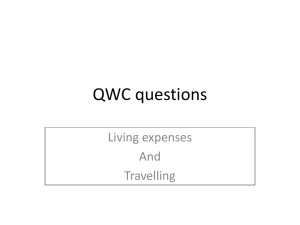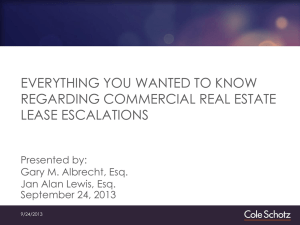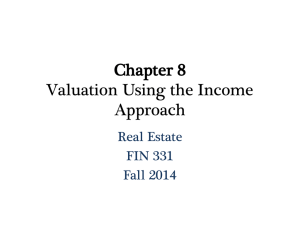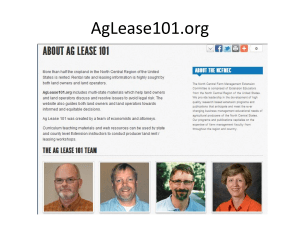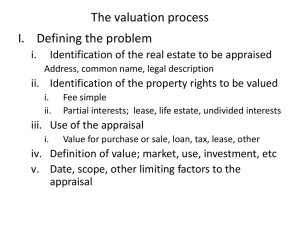IncomeVal
advertisement
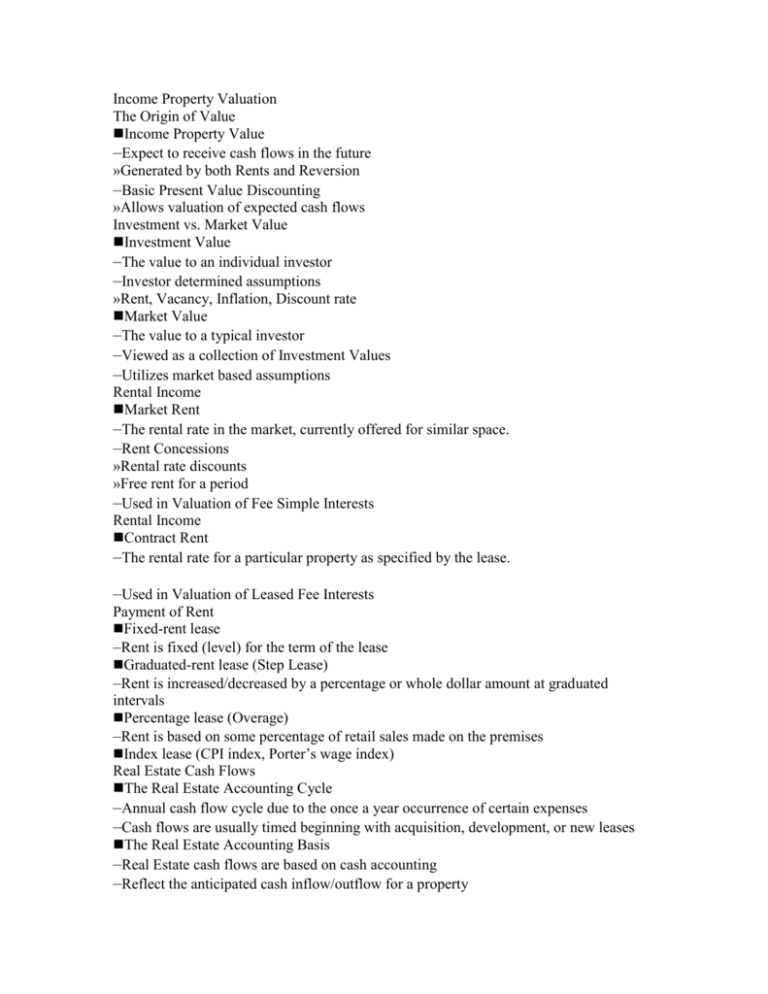
Income Property Valuation The Origin of Value Income Property Value –Expect to receive cash flows in the future »Generated by both Rents and Reversion –Basic Present Value Discounting »Allows valuation of expected cash flows Investment vs. Market Value Investment Value –The value to an individual investor –Investor determined assumptions »Rent, Vacancy, Inflation, Discount rate Market Value –The value to a typical investor –Viewed as a collection of Investment Values –Utilizes market based assumptions Rental Income Market Rent –The rental rate in the market, currently offered for similar space. –Rent Concessions »Rental rate discounts »Free rent for a period –Used in Valuation of Fee Simple Interests Rental Income Contract Rent –The rental rate for a particular property as specified by the lease. –Used in Valuation of Leased Fee Interests Payment of Rent Fixed-rent lease –Rent is fixed (level) for the term of the lease Graduated-rent lease (Step Lease) –Rent is increased/decreased by a percentage or whole dollar amount at graduated intervals Percentage lease (Overage) –Rent is based on some percentage of retail sales made on the premises Index lease (CPI index, Porter’s wage index) Real Estate Cash Flows The Real Estate Accounting Cycle –Annual cash flow cycle due to the once a year occurrence of certain expenses –Cash flows are usually timed beginning with acquisition, development, or new leases The Real Estate Accounting Basis –Real Estate cash flows are based on cash accounting –Reflect the anticipated cash inflow/outflow for a property Real Estate Cash Flows Pro-forma Statements –Forward looking cash flow statements »Year following estimates –Used in valuation and investment analysis Considerations in projecting cash flows –Forecast must be timely & consider trends –Sufficient detail for effective analysis »Reduction to proper units (sq.ft.) and extent (CAM) –Assumptions and limitations documented Real Estate Cash Flows Stabilizing Cash Flows –Cash flows are generally viewed on the basis of a typical year. –Extraordinary income variations are stabilized to exhibit a meaningful level cash flow –ie: Excess capital expenditures would not be included in a typical annual cash flow used for valuation and analysis –Methods include leveling an annuity Potential Gross Income (PGI) Defn: All the potential rental income attributable to the property without regard for vacancy –The total rental income to the property with 100% occupancy Market vs. Contract Rent –Market rent is used in fee simple analysis »Market rent is used when space is vacant –Contract rent is used in leased fee analysis »Rent Roll is used to enumerate contract rents Vacancy & Collection Loss Defn: A deduction to PGI due to unoccupied space or credit (bad debt) losses Market vs. Actual Vacancy –Market Vacancy is used in fee simple analysis »The average vacancy for a typical property –Actual Vacancy is used in leased fee analysis »Tenant turnover is accounted for Vacancy and Collection losses are summed Effective Gross Income (EGI) Defn: The anticipated income from operating a property reflecting the actual receipts –PGI less vacancy and collection loss –Included also is any additional income »Parking and vending, application and late fees Operating Expenses Methods of Expense Payment –Gross lease-landlord pays all operating expenses including fixed and variable expenses »Expense Stops –Net lease-tenant pays some or all expenses »Modified Net - Tenant pays some mix of fixed and variable expenses »Triple Net - Tenant pays all expenses to the property (Absolute Net) »Expense Reimbursements Operating Expenses Fixed Expenses –Expenses which do not vary with the level of occupancy »Real Estate Taxes »Property Insurance Variable Expenses –Expenses which vary based upon occupancy »Maintenance and janitorial services »Utilities »Management fees Net Operating Income (NOI) Defn: Income remaining after deducting operating expenses from EGI, but not including mortgage debt, depreciation, and income taxes. –NOI represents the net income a property is expected to generate, supporting both debt and equity components –NOI is the basis for overall property valuation and investment analysis Pre-Tax Cash Flow (PTCF) Defn: The amount of income remaining after annual mortgage debt (debt service) has been deducted from NOI. –This is equity income and is referred to as the “equity dividend” –PTCF is the cash return to the owner’s equity The Estimation Period Single Period –Operating cash flows estimated only for a single year, following the desired date of analysis Multi Period –Multiple cash flows estimated over consecutive years –The extent of estimates is based upon the anticipated Holding Period of the investment –Changes in Income and Expenses are accounted for Reversion Defn: The money an investor receives upon the sale of a property. (Reversion Value) –The price paid is based upon the new investor’s expectations of future income. Consistent application between cash flow from operations and reversion is needed Net Selling Price = Reversion – Sales Exp. PTER = NSP – Mortgage Balance Income Valuation Direct Capitalization –A valuation method used to convert a single year’s income estimate into an indication of property value –Calculated using a simple ratio known as a capitalization rate »Rate = Income / Value »Value = Income / Rate –Rates are derived from sales of similar properties or Mortgage/Equity techniques Income Valuation Overall Property Value –Using the overall income measure NOI –Apply the overall capitalization rate »OAR = NOI / Value (Selling Price) Property

